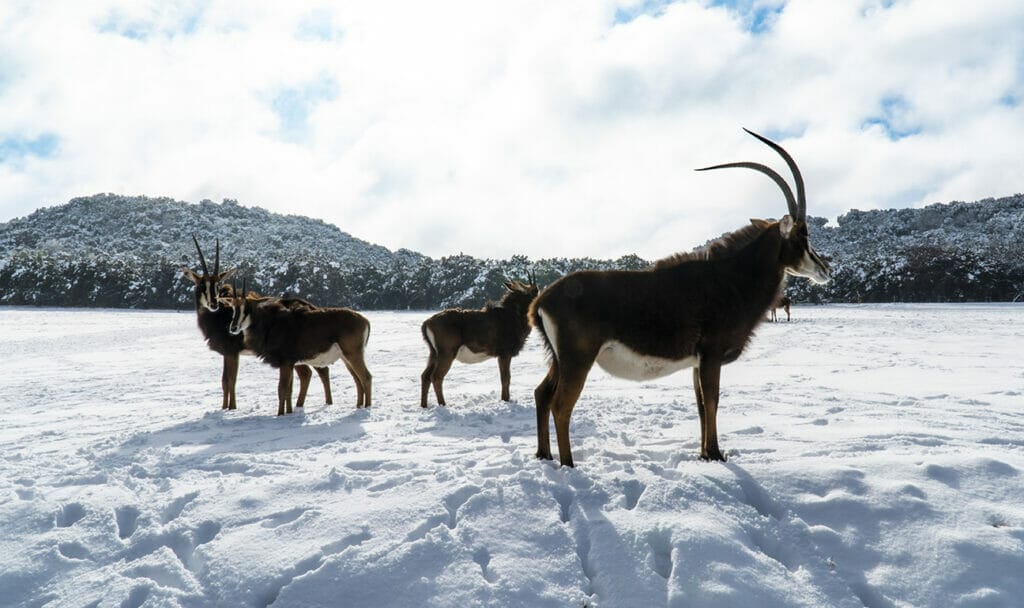Every year as December approaches, temperatures start dropping; and every year our guests ask the same question: “Wait, where are the giraffes?” Our giraffes need a little extra help to stay warm in chilly winter conditions. As soon as overnight temperatures hit below 50 degrees, you won’t be seeing them in their normal hang out spots. Instead, you can view them lounging in their fenced-in yard. If it’s too cold, however, they’ll stay hidden in their covered barn.
The same is true for our rhinos whenever temperatures reach below 40 degrees. We do this because not all of the species we house here are built for the chilly conditions. We’ve learned that putting these two species up during cold weather is what’s best for their health and safety. Guests are encouraged to check weather forecasts before visiting, and be prepared for any unpredictable changes.
So, now you may be asking yourself, “what’s there to see if the giraffes and rhinos aren’t out?” We talked to two members of our animal care team to explain why winter is such a unique viewing season.

Shifting Sights
As cold temperatures approach, the woody, underbrush-filled sections of our 1800 acres begin to shift. They go from groves of tightly packed green space to open ground with only trees as cover. Views that were previously hidden are suddenly accessible to guests! Here you’ll to find a variety of species hiding, huddled together under the warmth of the trees. If you look closely, you may even spot a calf tucked away by their mother for protection.
You may find our animals are even more active in winter than other seasons! The reason for that is two-fold, says Molly Shea, our Senior Animal Care Specialist. Not only are our animals not bogged down by heat, but they’re looking for food to keep their metabolisms running. If you stop by on a cold morning, you’ll often find species enjoying a meal and the opportunity to socialize and play without becoming overheated.
Changing Dynamic
This behavioral shift is common in many of our species, but it’s only amplified when our bigger animals (also known as megafauna), like giraffes and rhinos, are put away. As we remove the largest animals from the environment, all the smaller species adjust their behavior to fit the upgrade in space.
“When the giraffes go in, it changes the dynamic of that pasture instantly. Same with the rhino.” says Paige McNickle, our Curator of Hoofstock and Rhinos. “It changes the herd dynamics of other animals like our wildebeest and scimitar horned oryx. They move around and utilize new areas, and the ecosystem changes.”
Paige also pointed out that winter weather provides the perfect opportunity to see physical changes in our animals as they prepare for temperature changes. From our addax herd, whose coat becomes noticeably fluffier and darker to trap heat, to our Arabian oryx, whose winter coats look longer and shaggy. If you visit several times during the season, you may even be able to watch male deer transition from shaggy and buff during rut to sleek and antler-less afterwards.
Keeping Warm in Winter
Giraffe and rhino are put up on cold days—but what about our oher species? We have special methods to keep the rest of our animals safe during extreme weather (looking at you, February 2021). For starters, our animal care staff makes sure that all our hoofstock species have access to ample amounts of hay. This not only helps keep their body temperature high as they digest their meal, but provides warmth and insulation. It’s not uncommon to see herds of animals crowded around hay bales in the winter. Sometimes they even rest on the same hay they’re eating.

All of our species have access to shelter, be it man-made shed structures or thick groves of juniper trees. Some of our less cold-tolerant species, like mountain bongo, have access to heat as well as shelter. However, the majority of our animals don’t actually need much extra attention to ensure they stay warm in cold weather. Although you may associate African species with heat, these animals are just as adapted to the freezing desert nights as they are to the scorching hot days.
“These are animals that have evolved to live outside, and they’re smart enough to know how to keep living without us,” says Paige. “That’s the benefit of them being here; we’re keeping these animals in the way we do to help retain some of the knowledge and instinctual behaviors they have in the wild.”
These behaviors mean understanding when it’s cold enough to search for food, and when it’s time to huddle up with the herd for warmth.
As Molly puts it, “When there’s 40 sable in one shed all snuggled together, that creates a significant amount of body heat that they can share.”
In other words, our animals know just what to do to stay cozy this season. Though Fossil Rim might look different in the winter, there are plenty of unique behaviors and sights only visible this time of year. So stop by and enjoy the side of us most people don’t see!

